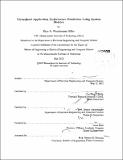| dc.contributor.advisor | Una-May O'Reilly, Saman Amarasinghe and Steve Muir. | en_US |
| dc.contributor.author | Wanderman-Milne, Skye A | en_US |
| dc.contributor.other | Massachusetts Institute of Technology. Dept. of Electrical Engineering and Computer Science. | en_US |
| dc.date.accessioned | 2013-03-01T15:06:26Z | |
| dc.date.available | 2013-03-01T15:06:26Z | |
| dc.date.copyright | 2012 | en_US |
| dc.date.issued | 2012 | en_US |
| dc.identifier.uri | http://hdl.handle.net/1721.1/77450 | |
| dc.description | Thesis (M. Eng.)--Massachusetts Institute of Technology, Dept. of Electrical Engineering and Computer Science, 2012. | en_US |
| dc.description | Cataloged from PDF version of thesis. | en_US |
| dc.description | Includes bibliographical references (p. 79-80). | en_US |
| dc.description.abstract | Virtualized datacenter administrators would like to consolidate virtual machines (VMs) onto as few physical hosts as possible in order to decrease costs, but must leave enough physical resources for each VM to meet application service level objectives (SLOs). The threshold between good and bad performance in terms of resource settings, however, is hard to determine and rarely static due to changing workloads and resource usage. Thus, in order to avoid SLO violations, system administrators must err on the side of caution by running fewer VMs per host than necessary or setting reservations, which prevents resources from being shared. To ameliorate this situation, we are working to design and implement a system that automatically monitors VM-level metrics to predict impending application SLO violations, and takes appropriate action to prevent the SLO violation from occurring. So far we have implemented the performance prediction, which is detailed in this document, while the preventative actions are left as future work. We created a three-stage pipeline in order to achieve scalable performance prediction. The three stages are prediction, which predicts future VM ESX performance counter values based on current time-series data; aggregation, which aggregates the predicted VM metrics into a single set of global metrics; and finally classification, which for each VM classifies its performance as good or bad based on the predicted VM counters and the predicted global state. Prediction of each counter is performed by a least-squares linear fit, aggregation is performed simply by summing each counter across all VMs, and classification is performed using a support vector machine (SVM) for each application. In addition, we created an experimental system running a MongoDB instance in order to test and evaluate our pipeline implementation. Our results on this experimental system are promising, but further research will be necessary before applying these techniques to a production system. | en_US |
| dc.description.statementofresponsibility | by Skye A. Wanderman-Milne. | en_US |
| dc.format.extent | 80 p. | en_US |
| dc.language.iso | eng | en_US |
| dc.publisher | Massachusetts Institute of Technology | en_US |
| dc.rights | M.I.T. theses are protected by
copyright. They may be viewed from this source for any purpose, but
reproduction or distribution in any format is prohibited without written
permission. See provided URL for inquiries about permission. | en_US |
| dc.rights.uri | http://dspace.mit.edu/handle/1721.1/7582 | en_US |
| dc.subject | Electrical Engineering and Computer Science. | en_US |
| dc.title | Virtualized application performance prediction using system metrics | en_US |
| dc.type | Thesis | en_US |
| dc.description.degree | M.Eng. | en_US |
| dc.contributor.department | Massachusetts Institute of Technology. Department of Electrical Engineering and Computer Science | |
| dc.identifier.oclc | 826522133 | en_US |
